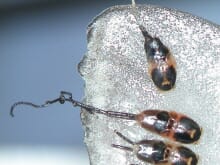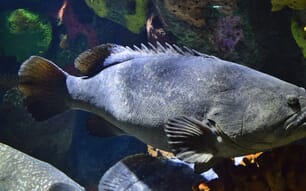
Photo: University of Massachusetts
In this industry of small margins every penny counts. For many producers, the number of sea lice infestations in close proximity can amount to make or break, so finding a solution is big business.
Sea lice are parasites. In abundance, they can cause major problems for producers. Not only are losses seen through injury, reduced growth rates and death, but also multiplied by preventative measures and complex environmental regulations.
The sea lice lives its life in stages. As they develop from eggs to adults, they shed an exoskeletons in a series of moults. In the first two stages of their life they are called nauplii. In the next, copepodid, stage, the lice develop the ability to attach themselves to fish. They then moult through four chalimus stages during which they are anchored to a host fish, enter another two - pre-adult - stages, before arriving at their final -- most lethal -- adult stage, where they are capable of crawling about the host fish.
In the fjords of Norway -- the largest producer of farmed salmon -- sea lice infestations have been harbouring for many years. Although the parasite lives naturally in these waters the introduction of salmon farms was followed by a reported explosion in sea lice numbers. The biological threat posed by sea lice to Norwegian salmon farms is now thought to be greater than any other and consequently, huge amounts of money have been invested in tackling it.
But it is not only the Norwegian salmon industry that is hindered by sea lice. In the pacific Northwest waters of the Canadian Archipelago sea lice have recently been at the centre of huge scientific debate. In one year alone they were estimated to have cost salmon farmers more than US$100 million - representing about 20 per cent of their total costs. Simultaneously, fears that wild salmon stocks are crashing as a consequence has led to large government funded research projects. The Pacific Salmon Forum's long anticipated report, released February 2009, acknowledged the "usual state of denial, disinterest, and inaction," of regulatory bodies said Watershed Watch Salmon Society. The society added that it was "gratifying", after many years of denial, to finally see recognition of sea lice impacts on wild stock.
A Threat to the Wild
In an ironic cycle of woe, the threat posed by wild salmon stock, was originally brought in by them. Naturally, sea lice provide little threat to wild salmon, but with the introduction of salmon farms the dangers can get amplified out of control.
As wild salmon swim from the open ocean back inland to spawn, they have to pass through river mouths and inlets clogged with salmon farms. Some of these wild salmon will be carrying parasites, which are little threat to the mature salmon due to its covering of mucus.
However, as the infected salmon pass near to the farm, the parasites sometimes jump ship. Due to the high density of salmon within these farms, once sea lice enter their populations can exist in much greater concentrations than seen in the wild. Essentially, they become a reservoir of infestation. As the salmon runs this gauntlet on its way back to the ocean it will be soon followed by the next generation of tiny smolts. With no mucus, no scales and no armour against the sea lice, many of them are killed.
With each progressive return to the spawning ground and each departure of a new generation the problem intensifies. A study in Canada's Broughton Archipelago showed how severe the problem could become. It is believed that the infestation had first taken hold four years - two generations - before the study began (2002). By the time the study was released in late 2007 the research it had amounted led it to claim that as much as 80 per cent of the annual pink salmon runs had been decimated as a direct result of the salmon farms.
The study, published in the journal Science, collected data on the number of wild pink salmon that return to seven rivers in the archipelago and compared their results with data from 64 farm-free rivers just north of the islands. They ran the data through a widely used fisheries model that calculates population growth rates and the model predicted a collapse of the wild population which resulted in complete annihilation just eight years later.
But despite of all the evidence for the contribution of salmon farm's to wild sea lice infections, the evidence is still denied by some. None believers claim that sea lice naturally adhere to the coast and have developed the capacity to know when the salmon runs take place and swarm towards the rivers to catch them.
In Search of the Solution
Ever since the threat of sea lice was first acknowledged government regulations have tried to get a grip on the problem. Delousing of fish farms is mandatory in most salmon producing countries. In Norway, treatments are carried out depending on sea louse counts, which require stringent surveillance measures.
But ridding the farm of sea lice has proven elusive. According to information from Bellona, a Norwegian non-profit foundation, one problem is that many of the pharmaceuticals used to keep populations low have dangerous environmental side affects. It is believed that sea lice may also be able to develop a resistance to these chemicals, weeding out the weaker sea lice and leaving a more resilient alternative in its place. In turn this would require a heavier use of pharmaceuticals, resulting in greater damage to the environment around it.
Pharmaceuticals for fish can either be fed to the fish in pellets, or added to the water, either way they will cause contamination and pollution. A more environmentally friendly alternative would be to enter wrasse fish in conjunction with the salmon farms, which naturally feed off on sea lice and rid the farms of the problem. However, using only this initiative, producers are often unable to rid the farms of an infestation and usually, the addition of pharmaceuticals are a must.
According to Bellona using lights to lure the salmon to depths where the sea lice cannot reach can also have beneficial affects. "This method is most relevant during the late autumn and winter," reports Bellona. "In the spring and summer the natural light will override the artificial light." Another natural approach is to boost natural resistance. Tests have proven that this can be achieved through amino acid-based feed that contains glucanes and extra vitamins. The Scottish report concluded that the group of salmon fed glucanes had on average 24.4 per cent fewer lice than the control group.
Scientists at the Institute of Marine Research, together with Aqua Gen AS (IMR), took a different initiative and investigated the possibility of reducing the vulnerability of farmed salmon to lice through selective breeding. Selective breeding has been successful in selecting for resistance to infectious salmon anaemia (ISA), infectious pancreatic necrosis (IPN), and the bacterial disease furunculosis. However, the research concluded that whilst such a goal would be theoretically possible, finance, time and other constraints may limit its practicality.
The real answer may instead lie with a salmon vaccine. The "Eukaryotic Parasites in Fish" project is working to develop preventive measures against salmon lice. According to Bellona, "this approach is building on the fact that the lice suck and digest blood from their host. If vital components of this blood digestion can be characterised, they may conceivably be used as antigens in a vaccine against salmon lice." Researchers believe, however, that there is far to go before such a vaccine is available.
Despite of a wide range of future prospects, it is clear that the successful salmon farm today must utilise a collaboration of current measures to keep sea lice at bay. The industry still waits for a real solution, but intense environmental and economic pressure will continue to rally until that day occurs - and if it does not occur soon, salmon farmers may find themselves pushed from the oceans, to inland facilities. The race is on.
February 2009




